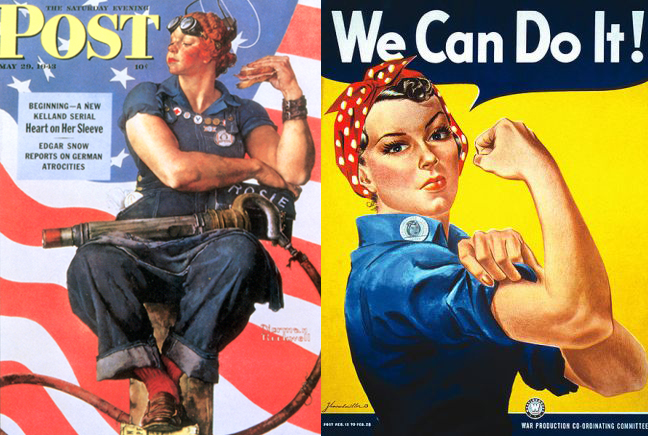LESSON PLAN:
The Changing Face of Woman: Propaganda and Popular Opinion from WWII
American women played a vital role in the Allies victory in WWII. More than 400,000 served in the military and millions worked in defense industries on the Home Front. WWII gave women new opportunities for work and independence. Some people viewed these changes as positive, some as negative. Many people were ambivalent about the social changes that effected women during the war. This ambivalence can be explored in contemporary images of women from that era.
Objective:
Students will learn about the social expectations brought about by women entering the workforce during WWII by analyzing portrayals of women in wartime propaganda.
Grade Level: 7-12
Standards:
History Thinking Standard 4—the student interrogates historical data by uncovering the social, political, and economic context in which it was created. Historical Thinking Standard 5—the student identifies issues and problems in the past and analyzes the interests, values, perspectives, and points of view of those involved in the situation.
Content Era 8 (1929-1945) Standard 3C—the student understands the effects of World War II at home and can analyze the effects of World War II on gender roles and the American family.
Time Requirement: One to two class periods
Download a printable pdf version of this lesson plan
Directions:
1. Present a brief lesson on women’s experiences of WWII. Included in the lesson is a Fact Sheet on American women in WWII that is helpful. Focus on the fact that large numbers of women went to work to increase war production. Ask students what social conflicts this may have caused. Discuss propaganda. Make sure students understand what propaganda is and how it specifically worked during WWII. There is a definition on the Rosie the Riveter page that is very clear.
2. Pass out copies of the two images of Rosie the Riveter. Explain what a riveter is: a person who bonds two pieces of metal together with a nail-like bolt. Ships, planes, and other wartime vehicles were constructed with rivets. Students may either answer the questions individually or as pairs on a separate sheet of paper, or you may hold a group discussion using the questions. Remind students to pay close attention to details when analyzing propaganda posters.
3. If students answer questions on their own, end the class with a class discussion. Discuss each question as a group.
Assessment:
Components for assessment include the written questions and the class discussion.
Enrichment:
Have students look through current magazines for pictures of women and answer the following questions: What is the purpose of the picture? Do you consider it to be propaganda? Why or why not? What characteristics does each woman possess? Do you like the picture—why or why not?
The Changing Face of Women
Compare these two images from 1943 of a woman war worker. The one on the left was painted by Norman Rockwell and appeared on the cover of the popular weekly magazine Saturday Evening Post. Graphic artist J. Howard Miller for the Westinghouse Corporation produced the one on the right.

Rockwell’s woman has a big, muscular body and a dirty face. She holds her rivet gun and her lunch box with the name Rosie in her lap. Her feet are resting on a copy of Hitler’s Mein Kampf. The woman in Miller’s image has fingernail polish, lipstick, rouge, plucked eyebrows and mascara. She is wearing a bandanna and a work shirt and her company’s identification button.
What is Propaganda?
The widespread, systematic promotion of particular ideas, doctrines, or practices. All governments used propaganda to educate, inspire, and encourage their citizens to support the war effort. The U.S. government produced posters, pamphlets, newsreels, radio shows, even comic books to rally the country’s spirit and resolve.
Questions to Discuss
Directions: Answer the following questions about the two depictions of Rosie the Riveter.
1. What do these two women have in common?
2. How do they differ?
3. Which image do you think became more popular with the public during the war? Why?
4. How do these images go against the usual portrayal of women during the era?
5. Which image do you like better? Why?
6. What was the purpose of these images?
7. Do these images fit the definition of propaganda? Why or why not?
Download a printable pdf version of this lesson plan
TAKE ACTION:


EDUCATION PROJECTS:
Student Travel – WWII Educational Tours
High school and college students, learn the leadership principles that helped win WWII on a trip to France or during a weeklong residential program in New Orleans. College credit is available, and space is limited.
See You Next Year! HS Yearbooks from WWII
Collected from across the United States, the words and pictures of these yearbooks present a new opportunity to experience the many challenges, setbacks and triumphs of the war through the eyes of America’s youth.
The Victory Gardens of WWII
Visit the Classroom Victory Garden Project website to learn about food production during WWII, find lesson plans and activities for elementary students, get tips for starting your own garden and try out simple Victory Garden recipes!
The Science and Technology of WWII
Visit our new interactive website to learn about wartime technical and scientific advances that forever changed our world. Incorporates STEM principles to use in the classroom.
Kids Corner: Fun and Games!
Make your own propaganda posters, test your memory, solve puzzles and more! Learn about World War II and have fun at the same time.



